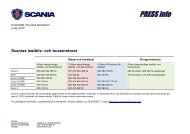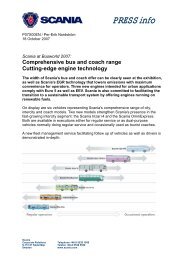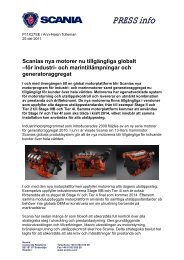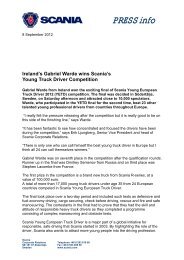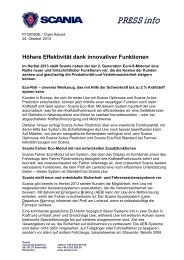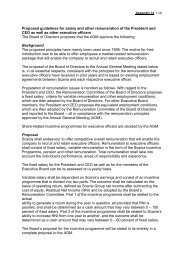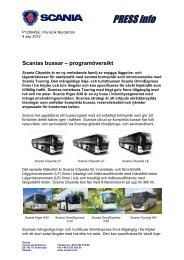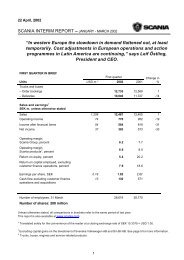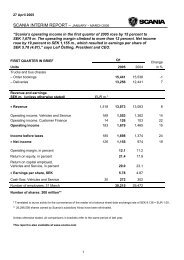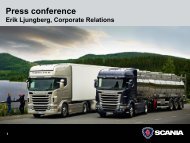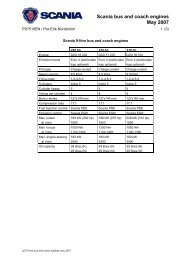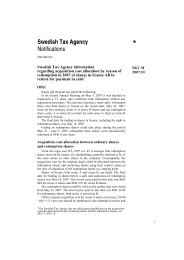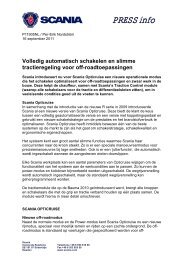Scania Annual Report 2011
Scania Annual Report 2011
Scania Annual Report 2011
Create successful ePaper yourself
Turn your PDF publications into a flip-book with our unique Google optimized e-Paper software.
94<br />
notes to the consolidated financial statements<br />
NOTE 2 Key judgements and estimates<br />
The key judgements and estimates for accounting purposes that are<br />
discussed in this section are those that Group Management and the<br />
Board of Directors deem the most important for an understanding of<br />
<strong>Scania</strong>’s financial reports, taking into account the degree of significant<br />
influence and uncertainty. These judgements are based on historical<br />
experience and the various assumptions that Management and the<br />
Board deem reasonable under the prevailing circumstances. The<br />
conclusions drawn in this way provide the basis for decisions regardin g<br />
recognised values of assets and liabilities, in those cases where these<br />
cannot easily be established through information from other sources.<br />
Actual outcomes may diverge from these judgements if other assumptions<br />
are made or other conditions emerge. Note 1 presents the<br />
accounting principles the company has chosen to apply. Important<br />
estimates and judgements for accounting purposes are attributable to<br />
the following areas.<br />
Obligations<br />
<strong>Scania</strong> delivers about 10 percent of its vehicles with residual value<br />
obliga tions or repurchase obligations. These are recognised as operating<br />
lease contracts, with the consequence that recognition of revenue<br />
and earnings is allocated over the life of the obligation.<br />
If there are major downturns in the market value of used vehicles,<br />
this increases the risk of future losses when divesting the returned<br />
vehicles. When a residual value guarantee is deemed likely to result<br />
in a future loss, a provision is recognised in those cases where the<br />
expected loss exceeds the profit on the vehicle not yet recognised as<br />
revenue.<br />
Changes in market value may also cause an impairment loss in<br />
used vehicle inventories, since these are recognised at the lower of<br />
cost and estimated net realisable value.<br />
At the end of <strong>2011</strong>, obligations related to residual value or<br />
repurchas e amounted to SEK 7,762 m. (6,522).<br />
Credit risks<br />
In its Financial Services operations, <strong>Scania</strong> has an exposure in the<br />
form of contractual payments. At the end of <strong>2011</strong>, these amounted to<br />
SEK 42,235 m. (36,137). In all essential respects, <strong>Scania</strong> has collateral<br />
in the form of the right to repossess the underlying vehicle. In case<br />
the marke t value of the collateral does not cover the exposure to the<br />
custome r, and the customer has a problem completing its contractua l<br />
payments, <strong>Scania</strong> has a risk of loss. On 31 December <strong>2011</strong>, the<br />
reserve for doubtful receivables in Financial Services operations<br />
amounted to SEK 745 m. (817). See also “credit risk exposure” under<br />
Note 30, “Financial instruments and financial risk management”.<br />
Intangible assets<br />
Intangible assets at <strong>Scania</strong> are essentially attributable to capitalised<br />
product development expenditures and “acquisition goodwill”. All<br />
goodwill items at <strong>Scania</strong> stem from acquisitions of previously independent<br />
importers/dealerships. All goodwill items are subject to an annual<br />
impairment test, which is mainly based on recoverable amounts,<br />
including important assumptions on the sales trend, margin and<br />
discount rate before tax; see also below. In the long term, the increase<br />
in sales of <strong>Scania</strong>’s products is deemed to be closely correlated with<br />
economic growth (GDP) in each respective market, which has been<br />
estimated at between 2 and 5 percent. The revenue/cost ratio, or<br />
margi n, for both vehicles and service is kept constant over time<br />
compared to the latest known level. When discounting to present<br />
value, <strong>Scania</strong> uses its average cost of equity (currently 11 percent<br />
before taxes).<br />
These assumptions do not diverge from information from external<br />
information sources or from earlier experience. To the extent the above<br />
parameters change negatively, an impairment loss may arise. On 31<br />
December <strong>2011</strong>, <strong>Scania</strong>’s goodwill amounted to SEK 1,144 m. (1,167).<br />
The impairment tests that were carried out showed that there are<br />
ample margins before impairment losses will arise.<br />
<strong>Scania</strong>’s development costs are capitalised in the phase of product<br />
development where decisions are made on future production and<br />
market introduction. At that time there is future predicted revenue and<br />
a corresponding production cost. In case future volume or the price<br />
and cost trend diverges negatively from the preliminary calculation, an<br />
impairment loss may arise. <strong>Scania</strong>’s capitalised development costs<br />
amounted to SEK 1,292 m. (1,074) on 31 December <strong>2011</strong>.<br />
Pension obligations<br />
In the actuarial methods that are used to establish <strong>Scania</strong>’s pension<br />
liabilities, a number of assumptions are highly important. The most<br />
critical ones are related to the discount rate on the obligations and<br />
expected return on managed assets. Other vital assumptions are<br />
the estimated pace of wage and salary increases and estimated life<br />
expectancy. A higher discount rate decreases the recognised pension<br />
liability. In calculating the Swedish pension liability, as in 2010 and<br />
2009, the discount rate used was 4.0 percent. Changes in the<br />
above-mentioned actuarial parameters are recognised in “Other<br />
comprehensive income”, net after taxes.<br />
financial reports <strong>Scania</strong> <strong>2011</strong>



